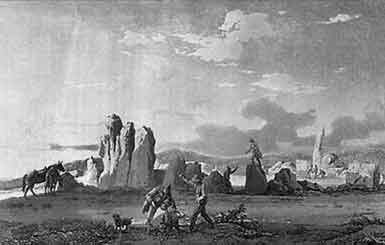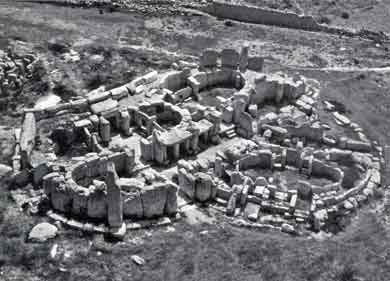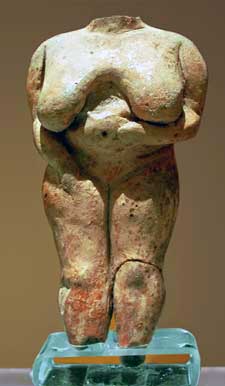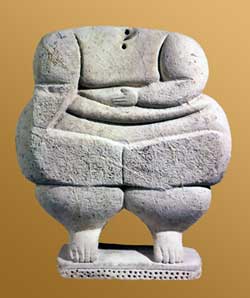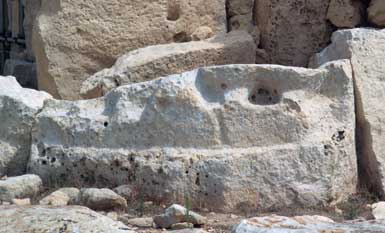
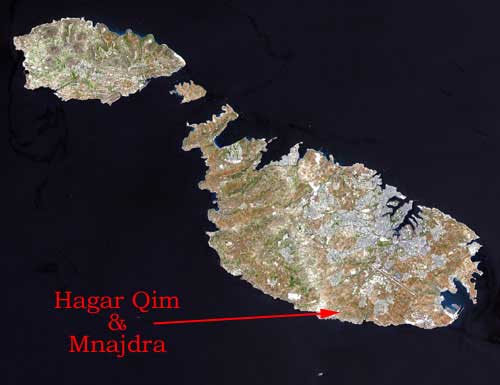
The ruins of Hagar Qim (“standing stones”) were well-known throughout the island’s later history and became a popular attraction for early visitors and antiquarians. As the engraving by Jean-Pierre Houel (far right) shows, only the highest stones were visible. The archaeological significance of the site was obvious and in 1839 the British governor, Sir Henry Bouverie, funded the clearance of the temple by J. G. Vance. This amounted to little more than a plundering expedition and proper excavations did not take place until 1885 under the direction of the island’s chief librarian, Dr. A. A. Caruana. Part of his brief was the re-erection of many of the fallen stones in order to restore the monument to something like its original condition. Since then, the work of restoration and consolidation of the temple has continued.
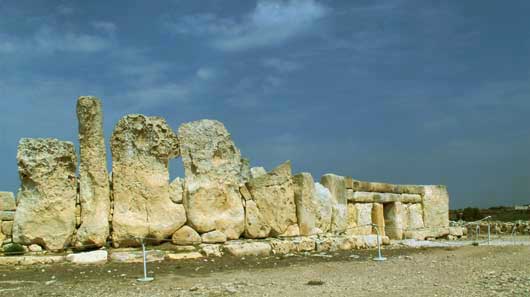
The site is actually a complex of at least three buildings. In addition to the Main Temple, there is a smaller, 5-apse temple to the north and another building of unknown function to the east. The location is a dramatic one, commanding sweeping views of the south coast of Malta, and the site is a prominent landmark. It has been dated to the Tarxien Phase (c. 3150-2500 BC).
It on a low rise at the top of the slope, overlooking the temple of Mnajdra barely 500 metres away but facing southeast. The builders used locally available Globigerina limestone rather than hauling in more durable Corallines from some distance away. As a consequence, the exposed parts of Hagar Qim have suffered quite a bit from rain and wind. In 2009, in order to protect the site from further erosion, a tent-like canopy was erected. In February 2011 the canopy was shredded by gale-force winds but no damage was sustained by the temple (this time).
The Main Temple
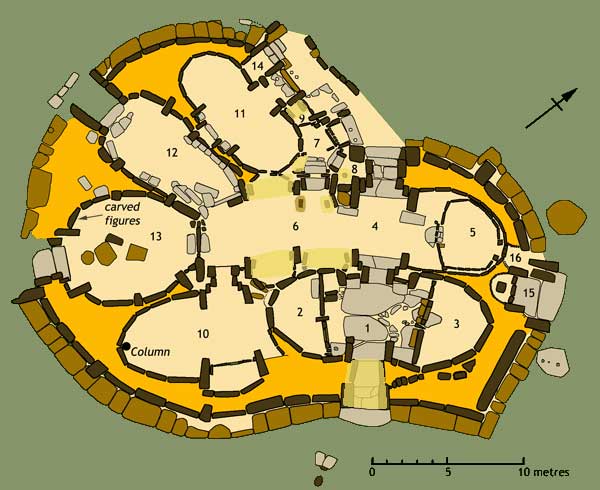
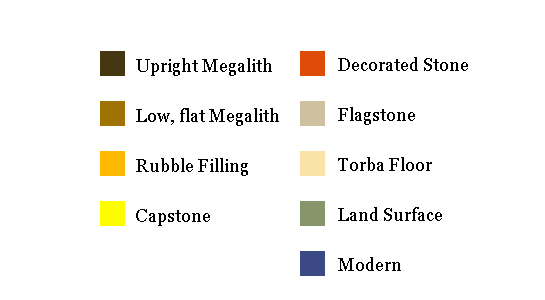
The design of the building is quite complex, perhaps the most complex of any of the temples, and was executed with a high level of skill and craftsmanship. The layout includes a variety of different suites with multiple entrances and a number of unique features. It was clearly a design that changed and evolved as the project went on.
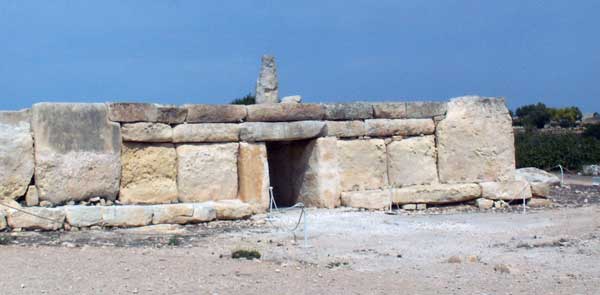
Hagar Qim. Entrance Façade
The façade, with its blocks of carefully dressed stone, is particularly impressive. The soft globigerinas were relatively easy to carve and the fact that the temple was largely buried until the nineteenth century meant that they have survived in reasonably good shape. Balance was the 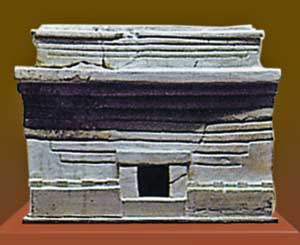 underlying principle. In the centre is a typical trilithon doorway flanked by three megaliths on either side. The two at the ends were much larger than the rest and had been notched near the top of their inner edges to accommodate the second of two courses of long, narrow stones. The masonry bears an uncanny resemblance to that in the model found at Tarxien (left). To either side of the doorway was a low stone bench that runs the whole length of the façade and apparently continues right round the building. Its purpose is unknown but a good guess would be that it was used to display sacred objects. In front of the doorway is a block with a V-shaped perforation—a feature that is found at some other sites and is generally thought to be for tethering animals. At the right hand end of the façade, the outer wall turns abruptly and there is another huge megalith, which weighs in at an estimated 20 tonnes. At the other end, the wall makes a more gentle turn as it curves around to the south. The megaliths here are the tallest of any of the temples, standing as much as 7 metres high.
underlying principle. In the centre is a typical trilithon doorway flanked by three megaliths on either side. The two at the ends were much larger than the rest and had been notched near the top of their inner edges to accommodate the second of two courses of long, narrow stones. The masonry bears an uncanny resemblance to that in the model found at Tarxien (left). To either side of the doorway was a low stone bench that runs the whole length of the façade and apparently continues right round the building. Its purpose is unknown but a good guess would be that it was used to display sacred objects. In front of the doorway is a block with a V-shaped perforation—a feature that is found at some other sites and is generally thought to be for tethering animals. At the right hand end of the façade, the outer wall turns abruptly and there is another huge megalith, which weighs in at an estimated 20 tonnes. At the other end, the wall makes a more gentle turn as it curves around to the south. The megaliths here are the tallest of any of the temples, standing as much as 7 metres high.
Essentially, the building should be seen as a single temple but it has so many unusual features and modifications that interpretation of the remains is extremely difficult. It would appear that the original plan was for a ‘standard’ four or five-apse temple (Spaces 1-6) but instead of a terminal 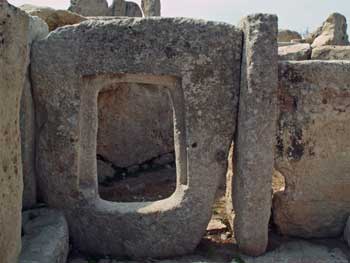 apse or niche there is another doorway at the rear of the building. It would appear that at some point the decision was taken to add more rooms (10-13) to the south and the external wall was substantially rebuilt to accommodate them. As was the case at other temples, such as Tarxien, one of the apses (6) was remodelled to provide access.
apse or niche there is another doorway at the rear of the building. It would appear that at some point the decision was taken to add more rooms (10-13) to the south and the external wall was substantially rebuilt to accommodate them. As was the case at other temples, such as Tarxien, one of the apses (6) was remodelled to provide access.
The main doorway led to a small court (1) with apses on either side. However, each of these apses are screened off by thin megalithic slabs. Access is through carved porthole in the central stone (the porthole leading to Apse 2 is shown, right). To the left was an elaborately carved pedestal altar with reliefs of potted plants on all four sides and a slab with pitted and spiral (‘oculus’) decoration. Five statues were found here in the 1830’s (including the so-called ‘Venus of Hagar Qim’) along with another four in Apse 2. Apart from the sculpture, little was found in either of the rather plainly finished outer apses.
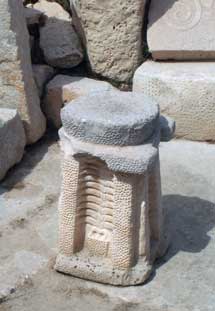
|
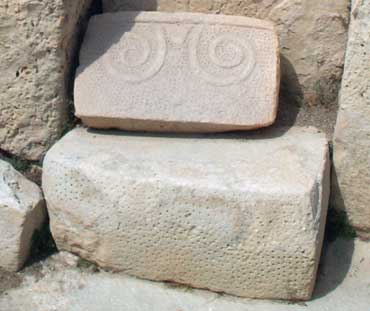
|
Further along, Apse 5 is characterized by fairly uniform megalithic architecture with a line of orthostats of uniform height supporting a number of courses of corbelled masonry. Inside the room is a curved setting of smaller upright slabs set just inside the wall. David Trump offers the opinion that it was some sort of animal pen but this cannot be proven. In the wall is small aperture known as an ‘oracle hole’ that connects the room to a small shrine (16) on the exterior of the building. In this case, however, the hole is positioned so that the light of the rising sun shines into the apse on the day of the summer solstice.
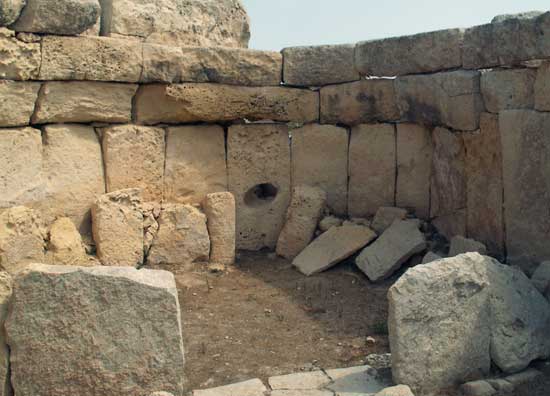
Hagar Qim. Apse 5 with interior stone setting & ‘oracle hole’
Apse 6, in addition to serving as the link to the rest of the temple, was an important cult area in its own right. There are no less than three roofed niches and two pedestal altars (below left). The altars flank the entrance to Room 7, an oddly shaped little 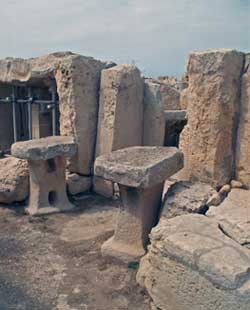 space but one that contained a number of niches. It also gives access to the even smaller Room 8, which contains yet another pedestal altar. A set of steps leads from Apse 6 to Room 10, which is at a higher level, and it was under these that a cache of three statues and a fragment of a fourth were found during restoration work in 1949. They include both standing and seated limestone figures of the “goddess”. Room 10 was part of an additional temple but one with a highly modified plan owing to the existence of Apse 2, which was apparently considered too important to be demolished. There is a small shrine opposite the doorway and a carved monolith at the back end of the apse. This type of object is often described as a baetyl and was an object of worship in the Eastern Mediterranean.
space but one that contained a number of niches. It also gives access to the even smaller Room 8, which contains yet another pedestal altar. A set of steps leads from Apse 6 to Room 10, which is at a higher level, and it was under these that a cache of three statues and a fragment of a fourth were found during restoration work in 1949. They include both standing and seated limestone figures of the “goddess”. Room 10 was part of an additional temple but one with a highly modified plan owing to the existence of Apse 2, which was apparently considered too important to be demolished. There is a small shrine opposite the doorway and a carved monolith at the back end of the apse. This type of object is often described as a baetyl and was an object of worship in the Eastern Mediterranean.
At the south end of Apse 6 is an opening that leads, through Room 13, to a less formal entrance to the temple. All that remains of the original furnishings of 13 are two pair of rather dainty looking carved stone feet, which were part of a large-scale twin-figure sculpture. The position of the statue is interesting—it faces into the wall filling—and was either not meant to be seen had been moved here from somewhere else (possibly after breakage). The adjacent room (12) is similarly plain and its function is unknown. Room 11 is the only part of the temple that is inaccessible from the rest of the interior and can only be reached by an external doorway. There are two apses and a terminal niche.
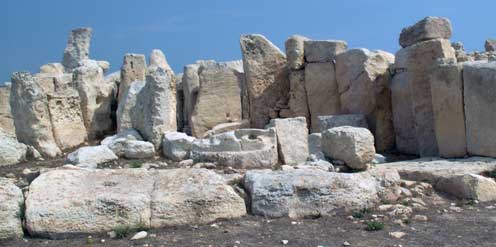
Hagar Qim. Room 13 showing the twin statue base
 There are a number of important external features that are part of the temple. Where the enclosure curves around to the east, there is a small external shrine—a deep niche with a triangular block to support a horizontal slab that served as the altar (right). It sits between a large solitary monolith 5.2 metres tall and the largest stone block in the outside wall of the temple—6.4 metres long and weighing in at over twenty tonnes. The purpose of the shrine may have been to allow more public ceremonies to be conducted but it is right next to the oracle hole mentioned above and so may have had a calendrical connection, marking the turn of the seasons.
There are a number of important external features that are part of the temple. Where the enclosure curves around to the east, there is a small external shrine—a deep niche with a triangular block to support a horizontal slab that served as the altar (right). It sits between a large solitary monolith 5.2 metres tall and the largest stone block in the outside wall of the temple—6.4 metres long and weighing in at over twenty tonnes. The purpose of the shrine may have been to allow more public ceremonies to be conducted but it is right next to the oracle hole mentioned above and so may have had a calendrical connection, marking the turn of the seasons.
In addition to the main building, there are the remains of a small five-apse temple about 30 metres to the north. There are also traces of less formal looking structures immediately in front of the main entrance. A number of postholes have also been located at various places around the site. The nature of the relationship among all of these features is unknown but relationship there certainly was.

Entrance to the North Temple at Hagar Qim

